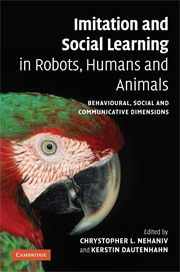 Imitation and Social Learning in Robots, Humans and Animals
Imitation and Social Learning in Robots, Humans and Animals Book contents
- Frontmatter
- Contents
- List of plates
- List of figures
- List of tables
- List of contributors
- Introduction: the constructive interdisciplinary viewpoint for understanding mechanisms and models of imitation and social learning
- Part I Correspondence problems and mechanisms
- Part II Mirroring and ‘mind-reading’
- Part III What to imitate?
- Part IV Development and embodiment
- 10 Copying strategies by people with autistic spectrum disorder: why only imitation leads to social cognitive development
- 11 A Bayesian model of imitation in infants and robots
- 12 Solving the correspondence problem in robotic imitation across embodiments: synchrony, perception and culture in artifacts
- Part V Synchrony and turn-taking as communicative mechanisms
- Part VI Why imitate? – Motivations
- Part VII Social feedback
- Part VIII The ecological context
- Index
- Plate section
- References
11 - A Bayesian model of imitation in infants and robots
Published online by Cambridge University Press: 10 December 2009
- Frontmatter
- Contents
- List of plates
- List of figures
- List of tables
- List of contributors
- Introduction: the constructive interdisciplinary viewpoint for understanding mechanisms and models of imitation and social learning
- Part I Correspondence problems and mechanisms
- Part II Mirroring and ‘mind-reading’
- Part III What to imitate?
- Part IV Development and embodiment
- 10 Copying strategies by people with autistic spectrum disorder: why only imitation leads to social cognitive development
- 11 A Bayesian model of imitation in infants and robots
- 12 Solving the correspondence problem in robotic imitation across embodiments: synchrony, perception and culture in artifacts
- Part V Synchrony and turn-taking as communicative mechanisms
- Part VI Why imitate? – Motivations
- Part VII Social feedback
- Part VIII The ecological context
- Index
- Plate section
- References
Summary
Introduction
Humans are often characterized as the most behaviourally flexible of all animals. Evolution has stumbled upon an unlikely but very effective trick for achieving this state. Relative to most other animals, we are born ‘immature’ and helpless. Our extended period of infantile immaturity, however, confers us with benefits. It allows us to learn and adapt to the specific physical and cultural environment into which we are born. Instead of relying on fixed reflexes adapted for specific environments, our learning capacities allow us to adapt to a wide range of ecological niches, from Alaska to Africa, modifying our shelter, skills, dress and customs accordingly. A crucial component of evolution's design for human beings is imitative learning, the ability to learn behaviours by observing the actions of others.
Human adults effortlessly learn new behaviours from watching others. Parents provide their young with an apprenticeship in how to behave as a member of the culture long before verbal instruction is possible. In Western culture, toddlers hold telephones to their ears and babble into thin air. There is no innate proclivity to treat hunks of plastic in this manner, nor is it due to trial-and-error learning. Imitation is chiefly responsible.
Over the past decade, imitative learning has received considerable attention from cognitive scientists, evolutionary biologists, neuroscientists and robotics researchers. Discoveries in developmental psychology have altered theories about the origins of imitation and its place in human nature.
- Type
- Chapter
- Information
- Imitation and Social Learning in Robots, Humans and AnimalsBehavioural, Social and Communicative Dimensions, pp. 217 - 248Publisher: Cambridge University PressPrint publication year: 2007
References
- 17
- Cited by


